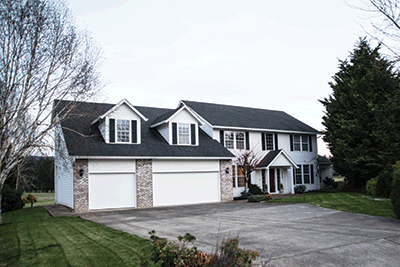You’ve heard it before: location, location, location. Where a home is located has “an awful lot to do with value,” said Mike Lamb, an associate broker with Vancouver-based Windermere Stellar Group.
For houses in the $450,000 to $550,000 range, Camas is the strongest market in Southwest Washington, followed closely by the Felida/Salmon Creek area, said Patrick Ginn, owner/broker with Ginn Realty Group, part of the Hasson Company. Lamb said that of the 20 half-million dollar homes closed in the last 30 days, seven were in Camas and seven were in Felida or Salmon Creek.
Part of the reason Camas and Salmon Creek are such hot markets for these homes, according to Lamb, is because their school districts have a good reputation. Other drivers of this price point, said Emile Bonfiglio, publisher of Luxury Home Magazine, include proximity to water (lakes and rivers) and elevation.
Oddly enough, though, explained Bonfiglio, Vancouver is unique in that it has pockets of nice homes next to homes that aren’t as nice. That is less true in Oregon, he said, where various cities tend to have 60 to 75 percent of their homes in a particular price range.
“I can think of 50 different places in Vancouver where there are luxury homes next to not so nice homes,” said Bonfiglio.
Pulling data from the RMLS, Ginn reported that 250 half-million dollar homes sold in Clark County and the Longview area in the last 12 months, with another 39 pending. He also said that 214 similar homes are on the market right now, with about 50 percent built in 2012 or later, compared to only 30 percent of the last years’ sales.
Smaller but nicer
Average square footage in these homes is decreasing slightly, from 3,500 square feet in last years’ sales, to 3,276 square feet in the pending sales.
Bonfiglio said that since the recession, Americans are “getting by with less.” Builders are recognizing that, he said, and are building houses to accommodate this trend. Examples include just having four bedrooms instead of four bedrooms plus a den and a bonus room, or downsizing from a three-car garage to a two-car garage.
Another factor related to the decrease in square footage is demographics. Bonfiglio said that as they approach their 60s, baby boomers generally don’t need really large homes – they don’t want to clean them, furnish them or pay taxes on them. However, Lamb said that many baby boomers are “not downsizing when you expect them to,” and are putting off that “last house” until their 70s.
Although square footage of the average half-million dollar home in Southwest Washington has decreased slightly, the price per square foot is rising, from $140/sf (last 12 months) to $152/sf (pending sales), said Ginn. Kelly Helmes, vice president of New Tradition Homes, said that these homes are finished with customization and nice amenities, such as a gourmet kitchen with gas appliances and granite countertops, custom cabinetry and a master suite with a fully tiled walk-in shower that provides “more of a retreat-type atmosphere.” Outside, you might find an enlarged outdoor entertainment area with a fire pit or a covered area. Helmes added that newer homes in this price range are highly energy-efficient, which he said was important to modern home buyers.
In the half-million price range, Helmes said, the lot represents about 20 to 25 percent of the total package (usually about a 10,000 square-foot lot, although it could be as much as an acre in rural areas). Ginn said that over the last three years, the cost of unfinished lots has gone up 30 to 40 percent.
“If the lot goes up $40,000 – you either get a smaller lot, a smaller house or fewer amenities,” said Ginn, who added that building costs have gone up 10 percent or more.
A rising market
Bonfiglio said that the half-million dollar price range was economically beneficial for builders, because both people moving up from a less expensive house and people downsizing from larger homes are looking for them. According to Bonfiglio, these homes are purchased by 30 to 40 percent of the population, compared to only 5 percent for million-dollar homes. Helmes said that for New Tradition, about 25 percent of their buyers purchase houses at the half-million price point.
Low interest rates are also helping sales of these homes, which are in a transitional market between conventional and jumbo loans, said Lamb. Helmes reported that only 6 percent of loans in the last 40 years have been at such favorable interest rates.
“You’re getting a lot for your money,” said Helmes. “Also, home values are increasing so people can sell what they’re in and have more equity to invest.”
Helmes said that this situation is leading to an increase in cash transactions, a fact corroborated by Ginn, who reported that 25 percent of recent sales were paid for in cash. In addition, said Lamb, the market for higher-priced homes is positively influenced by the rising stock market.
According to Lamb, the half-million dollar home market is not fed only by demand from locals in Southwest Washington. For example, Ginn said he recently sold a $550,000 house to a couple who had been relocated by Boeing from up north.
With six to nine months of inventory available, which Lamb called a “good level,” the market for half-million dollar homes in Southwest Washington is strong.
“The prognosis is really good,” concluded Lamb.





